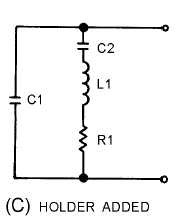2-8
Figure 2-6C.—Crystal symbol and equivalent circuits. HOLDER ADDED
The Q (discussed in chapter 1) of a crystal is many times greater than that of an LC tank circuit. The
high Q is present because the resistance in the crystal is extremely small. Commercially produced crystals
range in Q from 5,000 to 30,000. The high Q causes the frequency stability to be much greater than that
of an ordinary LC tank circuit. This is the reason a crystal is used in many sine-wave generator circuits.
Q-1. What are the two classifications of wave generators according to their output waveshapes?
Q-2. What are the three networks used for frequency-determining devices?
Q-3. What is another name for nonsinusoidal oscillators?
Q-4. What is a nonrotating device that produces alternating current?
Q-5. What are the three requirements necessary for oscillations to exist in a circuit?
SOLID-STATE LC OSCILLATORS
As you have just studied, a basic oscillator can be broken down into three main sections: a
frequency-determining device, an amplifier, and a feedback circuit. The frequency-determining device in
an LC oscillator is usually an LC tank circuit. Although the tank circuit is normally found in the input
circuit of an oscillator (both electron tube and transistor), it sometimes appears in the output circuit. The
differences in magnitude of plate and collector currents and shunting impedances are considerations in the
designed locations of such tank circuits. In both solid-state and electron tube circuits, oscillations take
place in the tuned circuit. Both the electron tube and the transistor function primarily as electrical valves
that amplify and automatically deliver to the input circuit the proper amount of energy to sustain
oscillations. In both tube and transistor oscillators, the feedback circuit couples energy of the proper
amount and of the correct phase from the output to the input circuit to sustain oscillations.
FEEDBACK
Let's review what you have studied up to this point concerning feedback. Feedback is the process of
transferring energy from a high-level point in a system to a low-level point in a system. This means
transferring energy from the output of an amplifier back to its input. If the output feedback signal opposes
the input signal, the signal is DEGENERATIVE or NEGATIVE FEEDBACK. However, if the feedback
aids the input signal, the feedback is REGENERATIVE or POSITIVE FEEDBACK. Regenerative or

